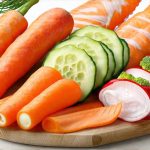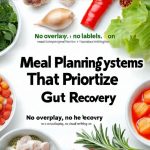Indigestion – that uncomfortable feeling of fullness, bloating, nausea, or even heartburn – is something most people experience at least occasionally. It’s rarely serious, but it can be incredibly disruptive to your day and leave you feeling miserable. Often triggered by what we eat (or how quickly we eat it), stress levels, or underlying sensitivities, recovering from an episode of indigestion isn’t about deprivation; it’s about thoughtfully reintroducing nourishment in a way that soothes your digestive system and allows it to heal. It’s about listening to your body and providing it with what it needs to get back on track.
The goal isn’t a rapid return to your usual diet, even if you feel tempted! Instead, think of building a recovery meal as a gentle progression – starting with easily digestible foods that won’t further irritate your system. This approach prioritizes rest for your gut and avoids overwhelming it with complex or stimulating ingredients. A successful recovery meal focuses on minimizing digestive effort while simultaneously providing essential nutrients to support the healing process. It’s about making conscious choices, not restrictive ones. You might even find building a gut friendly plan helpful in the long run.
The Foundations of a Recovery Meal
The core principle behind building an effective recovery meal is simplicity. Think bland, easily digestible foods that are gentle on your stomach and intestines. Avoid anything overly rich, fatty, spicy, or acidic – these will only exacerbate the discomfort. Focus instead on foods that are naturally soothing and readily absorbed. This isn’t a time for experimenting with new recipes or trying to force down large portions. Small, frequent “meals” (or snacks) throughout the day are often much better tolerated than three substantial meals.
What exactly falls into this category? Excellent choices include: – Boiled or steamed white rice – Plain toast or crackers – Bananas – a great source of potassium which can be depleted during bouts of nausea or vomiting – Applesauce – unsweetened is best – Broth-based soups (chicken noodle without heavy cream, for example) – Cooked carrots and potatoes without added butter or spices. These foods are low in fiber, which reduces the workload on your digestive system, and they’re generally well-tolerated even when your gut is sensitive.
Remember that hydration is also key! Indigestion can often lead to fluid loss through vomiting or diarrhea, so replenishing fluids is crucial. Water, herbal teas (ginger and chamomile are particularly soothing), and electrolyte solutions are all good options. Avoid sugary drinks, carbonated beverages, and alcohol, as these can further irritate your digestive system. Prioritizing hydration supports the overall recovery process. If you often experience discomfort after eating, learning how to ease symptoms could be beneficial.
Reintroducing Foods Gradually
Once you’ve established a baseline with those simple foods, you can start to slowly reintroduce other items into your diet. This should be done one food at a time, allowing yourself at least 24-48 hours between introductions to observe how your body reacts. Start with very small portions and pay close attention to any symptoms that return. If a particular food causes discomfort, remove it from your diet for the time being and try again later.
The order in which you reintroduce foods isn’t strictly defined, but generally, lean proteins are introduced before more complex carbohydrates or fats. Good options include: – Plain chicken breast (boiled or baked) – White fish (steamed or grilled without added seasonings) – Eggs – scrambled or hard-boiled are often easiest to digest. It’s essential to listen to your body during this phase and adjust accordingly. There’s no shame in sticking with the basic recovery foods for longer if that’s what feels right. If you have frequent issues, consider a gut test schedule to identify triggers.
This gradual reintroduction process is about rebuilding trust with your digestive system. You’re essentially retraining it to tolerate a wider range of foods without triggering symptoms. Be patient, consistent, and mindful throughout this phase, and you’ll be well on your way to a full recovery. Patience is paramount during the reintroduction phase.
The Role of Probiotics & Prebiotics
While not immediately after an acute episode, incorporating probiotics and prebiotics into your diet can play a significant role in long-term digestive health after the initial discomfort subsides. Probiotics are beneficial bacteria that live in your gut and help with digestion, nutrient absorption, and immune function. They can be found in fermented foods like yogurt (if you tolerate dairy) or kefir, as well as supplements. Prebiotics, on the other hand, are fibers that feed these beneficial bacteria, helping them thrive.
Good sources of prebiotics include bananas, oats, garlic, onions, and asparagus – introduce these very gradually after tolerating more basic foods. It’s important to note that some individuals may experience increased bloating or gas when first introducing probiotics or prebiotics, so start with small amounts and monitor your body’s response. A healthy gut microbiome is essential for optimal digestion, and supporting it can help prevent future episodes of indigestion. Sometimes a gut recovery meal plan is needed to start this process.
However, avoid probiotic supplements immediately after severe vomiting or diarrhea as they might exacerbate symptoms; focus on rehydration and basic food tolerance first. A balanced approach to probiotics and prebiotics supports long-term digestive wellness. After a period of overeating, you may need to reset your gut before focusing on probiotics.
Hydration Strategies Beyond Water
While water is the cornerstone of hydration, there are other strategies you can employ to replenish fluids and electrolytes effectively during recovery. Herbal teas, as mentioned earlier, offer soothing properties alongside hydration. Ginger tea can help alleviate nausea, while chamomile tea promotes relaxation. Electrolyte solutions – available in powder or liquid form – are particularly helpful if you’ve experienced vomiting or diarrhea.
Avoid sugary drinks like juice or soda, as they can actually worsen indigestion and lead to further dehydration. Carbonated beverages should also be avoided, as the bubbles can irritate your stomach. Sip fluids slowly throughout the day rather than gulping them down, which can overwhelm your digestive system. Consider making infused water with cucumber or berries for a more flavorful and hydrating option. Strategic hydration supports quicker recovery.
It’s important to remember that this information is not intended as medical advice. If you experience severe or persistent indigestion, or if it’s accompanied by other symptoms such as fever, weight loss, or blood in your stool, please consult a healthcare professional. They can help determine the underlying cause of your indigestion and recommend appropriate treatment options. Taking proactive steps to nourish your body after an episode of indigestion is a sign of self-care and respect for your digestive health.


















